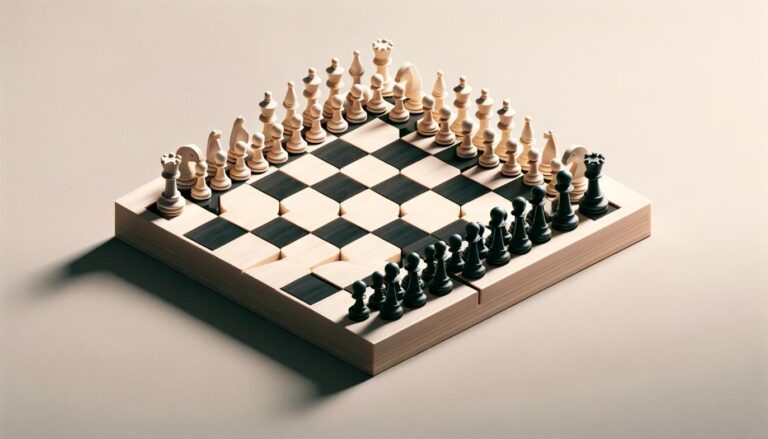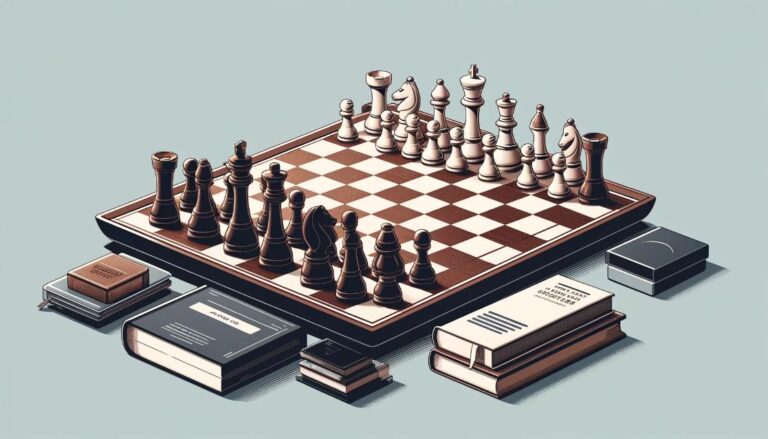Common Chess Tactics
Here are some of the most common chess tactics that intermediate players should know:
- Pins: A pin occurs when a more valuable piece is attacked by a less valuable piece, and it cannot move without exposing an even more valuable piece behind it. For example, a bishop pinning a knight to the king.
- Forks: A fork is a tactic in which one piece attacks two or more of the opponent´s pieces simultaneously. The opponent is forced to choose which piece to save, ultimately resulting in a loss of material.
- Skewers: A skewer is the opposite of a pin, where a more valuable piece attacks a less valuable piece, forcing it to move so the more valuable piece can capture a more valuable piece behind it. For example, a queen skewering a bishop and a rook.
- Discovered Attacks: A discovered attack occurs when a piece moves, revealing an attack by another piece behind it. This is a potent tactic as the opponent may not see the attack coming and have to deal with two threats at once.
- Deflection: Deflection is a tactic where a piece is moved, forcing an opponent´s piece to move away from a crucial square or line. This creates weaknesses in the opponent´s position that can be exploited.
Tips for Mastering Chess Tactics
Now that you know some of the common chess tactics, here are some tips to help you master them:
- Study Tactics: The first step to mastering tactics is to study and understand them. There are plenty of resources available that teach different tactics and their applications. Dedicate time to study and practice them regularly.
- Develop a Tactical Eye: A tactical eye refers to the ability to see potential threats and tactics on the chessboard. With practice, you can improve your tactical eye and start seeing opportunities that were previously invisible.
- Always Calculate: Calculating is a critical skill in chess, especially when it comes to tactics. Take your time to calculate all possible moves and consequences before making a move. This will help you avoid blunders and capitalize on tactics.
- Look for Patterns: Chess tactics often involve a specific pattern or theme. Train yourself to recognize these patterns on the board, and it will help you identify tactics more quickly.
- Play Practice Games: To improve your skills in applying tactics, play practice games with a focus on using different tactics. This will help you become more comfortable in executing tactics in real games.
Incorporating Tactics in Your Game
As an intermediate player, it is essential to know tactics, but it is equally important to know when and how to use them in a game. Here are some general tips to keep in mind:
- Assess the Position: Before considering tactical opportunities, assess the position on the board and determine the best course of action. Tactics are most effective when they fit well with your overall strategic plan.
- Be Patient: It can be tempting to execute a tactic as soon as you see it, but it is crucial to be patient and wait for the right moment. Rushing tactics can often backfire and give your opponent an advantage.
- Watch Out for Counterattacks: When executing a tactic, always be aware of potential counterattacks from your opponent. It is essential to calculate all possible responses before committing to a tactic.
- Take Risks: Sometimes, tactics may involve sacrificing material or creating slight weaknesses in your position. While these risks may seem daunting, they can often lead to significant advantages if executed correctly.
- Practice, Practice, Practice: The key to incorporating tactics into your game is practice. The more you study, practice, and apply tactics, the more natural and effective they will become for you.
Furthermore, in competitive chess, tactics are often used as a surprise element to throw off opponents and gain the upper hand in a game. Without a strong understanding and proficiency in tactics, it is challenging to achieve success in chess.
Common Chess Tactics
Here are some of the most common chess tactics that intermediate players should know:
- Pins: A pin occurs when a more valuable piece is attacked by a less valuable piece, and it cannot move without exposing an even more valuable piece behind it. For example, a bishop pinning a knight to the king.
- Forks: A fork is a tactic in which one piece attacks two or more of the opponent´s pieces simultaneously. The opponent is forced to choose which piece to save, ultimately resulting in a loss of material.
- Skewers: A skewer is the opposite of a pin, where a more valuable piece attacks a less valuable piece, forcing it to move so the more valuable piece can capture a more valuable piece behind it. For example, a queen skewering a bishop and a rook.
- Discovered Attacks: A discovered attack occurs when a piece moves, revealing an attack by another piece behind it. This is a potent tactic as the opponent may not see the attack coming and have to deal with two threats at once.
- Deflection: Deflection is a tactic where a piece is moved, forcing an opponent´s piece to move away from a crucial square or line. This creates weaknesses in the opponent´s position that can be exploited.
Tips for Mastering Chess Tactics
Now that you know some of the common chess tactics, here are some tips to help you master them:
- Study Tactics: The first step to mastering tactics is to study and understand them. There are plenty of resources available that teach different tactics and their applications. Dedicate time to study and practice them regularly.
- Develop a Tactical Eye: A tactical eye refers to the ability to see potential threats and tactics on the chessboard. With practice, you can improve your tactical eye and start seeing opportunities that were previously invisible.
- Always Calculate: Calculating is a critical skill in chess, especially when it comes to tactics. Take your time to calculate all possible moves and consequences before making a move. This will help you avoid blunders and capitalize on tactics.
- Look for Patterns: Chess tactics often involve a specific pattern or theme. Train yourself to recognize these patterns on the board, and it will help you identify tactics more quickly.
- Play Practice Games: To improve your skills in applying tactics, play practice games with a focus on using different tactics. This will help you become more comfortable in executing tactics in real games.
Incorporating Tactics in Your Game
As an intermediate player, it is essential to know tactics, but it is equally important to know when and how to use them in a game. Here are some general tips to keep in mind:
- Assess the Position: Before considering tactical opportunities, assess the position on the board and determine the best course of action. Tactics are most effective when they fit well with your overall strategic plan.
- Be Patient: It can be tempting to execute a tactic as soon as you see it, but it is crucial to be patient and wait for the right moment. Rushing tactics can often backfire and give your opponent an advantage.
- Watch Out for Counterattacks: When executing a tactic, always be aware of potential counterattacks from your opponent. It is essential to calculate all possible responses before committing to a tactic.
- Take Risks: Sometimes, tactics may involve sacrificing material or creating slight weaknesses in your position. While these risks may seem daunting, they can often lead to significant advantages if executed correctly.
- Practice, Practice, Practice: The key to incorporating tactics into your game is practice. The more you study, practice, and apply tactics, the more natural and effective they will become for you.
Mastering tactics allows players to see opportunities on the board and capitalize on them. It also helps players improve their calculative abilities and pattern recognition skills, allowing them to anticipate their opponent´s moves and plan accordingly.
Furthermore, in competitive chess, tactics are often used as a surprise element to throw off opponents and gain the upper hand in a game. Without a strong understanding and proficiency in tactics, it is challenging to achieve success in chess.
Common Chess Tactics
Here are some of the most common chess tactics that intermediate players should know:
- Pins: A pin occurs when a more valuable piece is attacked by a less valuable piece, and it cannot move without exposing an even more valuable piece behind it. For example, a bishop pinning a knight to the king.
- Forks: A fork is a tactic in which one piece attacks two or more of the opponent´s pieces simultaneously. The opponent is forced to choose which piece to save, ultimately resulting in a loss of material.
- Skewers: A skewer is the opposite of a pin, where a more valuable piece attacks a less valuable piece, forcing it to move so the more valuable piece can capture a more valuable piece behind it. For example, a queen skewering a bishop and a rook.
- Discovered Attacks: A discovered attack occurs when a piece moves, revealing an attack by another piece behind it. This is a potent tactic as the opponent may not see the attack coming and have to deal with two threats at once.
- Deflection: Deflection is a tactic where a piece is moved, forcing an opponent´s piece to move away from a crucial square or line. This creates weaknesses in the opponent´s position that can be exploited.
Tips for Mastering Chess Tactics
Now that you know some of the common chess tactics, here are some tips to help you master them:
- Study Tactics: The first step to mastering tactics is to study and understand them. There are plenty of resources available that teach different tactics and their applications. Dedicate time to study and practice them regularly.
- Develop a Tactical Eye: A tactical eye refers to the ability to see potential threats and tactics on the chessboard. With practice, you can improve your tactical eye and start seeing opportunities that were previously invisible.
- Always Calculate: Calculating is a critical skill in chess, especially when it comes to tactics. Take your time to calculate all possible moves and consequences before making a move. This will help you avoid blunders and capitalize on tactics.
- Look for Patterns: Chess tactics often involve a specific pattern or theme. Train yourself to recognize these patterns on the board, and it will help you identify tactics more quickly.
- Play Practice Games: To improve your skills in applying tactics, play practice games with a focus on using different tactics. This will help you become more comfortable in executing tactics in real games.
Incorporating Tactics in Your Game
As an intermediate player, it is essential to know tactics, but it is equally important to know when and how to use them in a game. Here are some general tips to keep in mind:
- Assess the Position: Before considering tactical opportunities, assess the position on the board and determine the best course of action. Tactics are most effective when they fit well with your overall strategic plan.
- Be Patient: It can be tempting to execute a tactic as soon as you see it, but it is crucial to be patient and wait for the right moment. Rushing tactics can often backfire and give your opponent an advantage.
- Watch Out for Counterattacks: When executing a tactic, always be aware of potential counterattacks from your opponent. It is essential to calculate all possible responses before committing to a tactic.
- Take Risks: Sometimes, tactics may involve sacrificing material or creating slight weaknesses in your position. While these risks may seem daunting, they can often lead to significant advantages if executed correctly.
- Practice, Practice, Practice: The key to incorporating tactics into your game is practice. The more you study, practice, and apply tactics, the more natural and effective they will become for you.
Chess is a game of strategy and tactics. While strategy focuses on long-term plans and positional advantages, tactics focus on short-term moves that lead to an immediate advantage.
Mastering tactics allows players to see opportunities on the board and capitalize on them. It also helps players improve their calculative abilities and pattern recognition skills, allowing them to anticipate their opponent´s moves and plan accordingly.
Furthermore, in competitive chess, tactics are often used as a surprise element to throw off opponents and gain the upper hand in a game. Without a strong understanding and proficiency in tactics, it is challenging to achieve success in chess.
Common Chess Tactics
Here are some of the most common chess tactics that intermediate players should know:
- Pins: A pin occurs when a more valuable piece is attacked by a less valuable piece, and it cannot move without exposing an even more valuable piece behind it. For example, a bishop pinning a knight to the king.
- Forks: A fork is a tactic in which one piece attacks two or more of the opponent´s pieces simultaneously. The opponent is forced to choose which piece to save, ultimately resulting in a loss of material.
- Skewers: A skewer is the opposite of a pin, where a more valuable piece attacks a less valuable piece, forcing it to move so the more valuable piece can capture a more valuable piece behind it. For example, a queen skewering a bishop and a rook.
- Discovered Attacks: A discovered attack occurs when a piece moves, revealing an attack by another piece behind it. This is a potent tactic as the opponent may not see the attack coming and have to deal with two threats at once.
- Deflection: Deflection is a tactic where a piece is moved, forcing an opponent´s piece to move away from a crucial square or line. This creates weaknesses in the opponent´s position that can be exploited.
Tips for Mastering Chess Tactics
Now that you know some of the common chess tactics, here are some tips to help you master them:
- Study Tactics: The first step to mastering tactics is to study and understand them. There are plenty of resources available that teach different tactics and their applications. Dedicate time to study and practice them regularly.
- Develop a Tactical Eye: A tactical eye refers to the ability to see potential threats and tactics on the chessboard. With practice, you can improve your tactical eye and start seeing opportunities that were previously invisible.
- Always Calculate: Calculating is a critical skill in chess, especially when it comes to tactics. Take your time to calculate all possible moves and consequences before making a move. This will help you avoid blunders and capitalize on tactics.
- Look for Patterns: Chess tactics often involve a specific pattern or theme. Train yourself to recognize these patterns on the board, and it will help you identify tactics more quickly.
- Play Practice Games: To improve your skills in applying tactics, play practice games with a focus on using different tactics. This will help you become more comfortable in executing tactics in real games.
Incorporating Tactics in Your Game
As an intermediate player, it is essential to know tactics, but it is equally important to know when and how to use them in a game. Here are some general tips to keep in mind:
- Assess the Position: Before considering tactical opportunities, assess the position on the board and determine the best course of action. Tactics are most effective when they fit well with your overall strategic plan.
- Be Patient: It can be tempting to execute a tactic as soon as you see it, but it is crucial to be patient and wait for the right moment. Rushing tactics can often backfire and give your opponent an advantage.
- Watch Out for Counterattacks: When executing a tactic, always be aware of potential counterattacks from your opponent. It is essential to calculate all possible responses before committing to a tactic.
- Take Risks: Sometimes, tactics may involve sacrificing material or creating slight weaknesses in your position. While these risks may seem daunting, they can often lead to significant advantages if executed correctly.
- Practice, Practice, Practice: The key to incorporating tactics into your game is practice. The more you study, practice, and apply tactics, the more natural and effective they will become for you.
Why are Chess Tactics Important?
Chess is a game of strategy and tactics. While strategy focuses on long-term plans and positional advantages, tactics focus on short-term moves that lead to an immediate advantage.
Mastering tactics allows players to see opportunities on the board and capitalize on them. It also helps players improve their calculative abilities and pattern recognition skills, allowing them to anticipate their opponent´s moves and plan accordingly.
Furthermore, in competitive chess, tactics are often used as a surprise element to throw off opponents and gain the upper hand in a game. Without a strong understanding and proficiency in tactics, it is challenging to achieve success in chess.
Common Chess Tactics
Here are some of the most common chess tactics that intermediate players should know:
- Pins: A pin occurs when a more valuable piece is attacked by a less valuable piece, and it cannot move without exposing an even more valuable piece behind it. For example, a bishop pinning a knight to the king.
- Forks: A fork is a tactic in which one piece attacks two or more of the opponent´s pieces simultaneously. The opponent is forced to choose which piece to save, ultimately resulting in a loss of material.
- Skewers: A skewer is the opposite of a pin, where a more valuable piece attacks a less valuable piece, forcing it to move so the more valuable piece can capture a more valuable piece behind it. For example, a queen skewering a bishop and a rook.
- Discovered Attacks: A discovered attack occurs when a piece moves, revealing an attack by another piece behind it. This is a potent tactic as the opponent may not see the attack coming and have to deal with two threats at once.
- Deflection: Deflection is a tactic where a piece is moved, forcing an opponent´s piece to move away from a crucial square or line. This creates weaknesses in the opponent´s position that can be exploited.
Tips for Mastering Chess Tactics
Now that you know some of the common chess tactics, here are some tips to help you master them:
- Study Tactics: The first step to mastering tactics is to study and understand them. There are plenty of resources available that teach different tactics and their applications. Dedicate time to study and practice them regularly.
- Develop a Tactical Eye: A tactical eye refers to the ability to see potential threats and tactics on the chessboard. With practice, you can improve your tactical eye and start seeing opportunities that were previously invisible.
- Always Calculate: Calculating is a critical skill in chess, especially when it comes to tactics. Take your time to calculate all possible moves and consequences before making a move. This will help you avoid blunders and capitalize on tactics.
- Look for Patterns: Chess tactics often involve a specific pattern or theme. Train yourself to recognize these patterns on the board, and it will help you identify tactics more quickly.
- Play Practice Games: To improve your skills in applying tactics, play practice games with a focus on using different tactics. This will help you become more comfortable in executing tactics in real games.
Incorporating Tactics in Your Game
As an intermediate player, it is essential to know tactics, but it is equally important to know when and how to use them in a game. Here are some general tips to keep in mind:
- Assess the Position: Before considering tactical opportunities, assess the position on the board and determine the best course of action. Tactics are most effective when they fit well with your overall strategic plan.
- Be Patient: It can be tempting to execute a tactic as soon as you see it, but it is crucial to be patient and wait for the right moment. Rushing tactics can often backfire and give your opponent an advantage.
- Watch Out for Counterattacks: When executing a tactic, always be aware of potential counterattacks from your opponent. It is essential to calculate all possible responses before committing to a tactic.
- Take Risks: Sometimes, tactics may involve sacrificing material or creating slight weaknesses in your position. While these risks may seem daunting, they can often lead to significant advantages if executed correctly.
- Practice, Practice, Practice: The key to incorporating tactics into your game is practice. The more you study, practice, and apply tactics, the more natural and effective they will become for you.
Mastering chess tactics is crucial for intermediate players as it allows them to outmaneuver their opponents and ultimately win the game.
Why are Chess Tactics Important?
Chess is a game of strategy and tactics. While strategy focuses on long-term plans and positional advantages, tactics focus on short-term moves that lead to an immediate advantage.
Mastering tactics allows players to see opportunities on the board and capitalize on them. It also helps players improve their calculative abilities and pattern recognition skills, allowing them to anticipate their opponent´s moves and plan accordingly.
Furthermore, in competitive chess, tactics are often used as a surprise element to throw off opponents and gain the upper hand in a game. Without a strong understanding and proficiency in tactics, it is challenging to achieve success in chess.
Common Chess Tactics
Here are some of the most common chess tactics that intermediate players should know:
- Pins: A pin occurs when a more valuable piece is attacked by a less valuable piece, and it cannot move without exposing an even more valuable piece behind it. For example, a bishop pinning a knight to the king.
- Forks: A fork is a tactic in which one piece attacks two or more of the opponent´s pieces simultaneously. The opponent is forced to choose which piece to save, ultimately resulting in a loss of material.
- Skewers: A skewer is the opposite of a pin, where a more valuable piece attacks a less valuable piece, forcing it to move so the more valuable piece can capture a more valuable piece behind it. For example, a queen skewering a bishop and a rook.
- Discovered Attacks: A discovered attack occurs when a piece moves, revealing an attack by another piece behind it. This is a potent tactic as the opponent may not see the attack coming and have to deal with two threats at once.
- Deflection: Deflection is a tactic where a piece is moved, forcing an opponent´s piece to move away from a crucial square or line. This creates weaknesses in the opponent´s position that can be exploited.
Tips for Mastering Chess Tactics
Now that you know some of the common chess tactics, here are some tips to help you master them:
- Study Tactics: The first step to mastering tactics is to study and understand them. There are plenty of resources available that teach different tactics and their applications. Dedicate time to study and practice them regularly.
- Develop a Tactical Eye: A tactical eye refers to the ability to see potential threats and tactics on the chessboard. With practice, you can improve your tactical eye and start seeing opportunities that were previously invisible.
- Always Calculate: Calculating is a critical skill in chess, especially when it comes to tactics. Take your time to calculate all possible moves and consequences before making a move. This will help you avoid blunders and capitalize on tactics.
- Look for Patterns: Chess tactics often involve a specific pattern or theme. Train yourself to recognize these patterns on the board, and it will help you identify tactics more quickly.
- Play Practice Games: To improve your skills in applying tactics, play practice games with a focus on using different tactics. This will help you become more comfortable in executing tactics in real games.
Incorporating Tactics in Your Game
As an intermediate player, it is essential to know tactics, but it is equally important to know when and how to use them in a game. Here are some general tips to keep in mind:
- Assess the Position: Before considering tactical opportunities, assess the position on the board and determine the best course of action. Tactics are most effective when they fit well with your overall strategic plan.
- Be Patient: It can be tempting to execute a tactic as soon as you see it, but it is crucial to be patient and wait for the right moment. Rushing tactics can often backfire and give your opponent an advantage.
- Watch Out for Counterattacks: When executing a tactic, always be aware of potential counterattacks from your opponent. It is essential to calculate all possible responses before committing to a tactic.
- Take Risks: Sometimes, tactics may involve sacrificing material or creating slight weaknesses in your position. While these risks may seem daunting, they can often lead to significant advantages if executed correctly.
- Practice, Practice, Practice: The key to incorporating tactics into your game is practice. The more you study, practice, and apply tactics, the more natural and effective they will become for you.
Tactics can be used to capture an opponent´s pieces, gain control of the center of the board, or create a checkmate situation. They require a combination of strategic thinking, calculation, and creativity to be successful.
Mastering chess tactics is crucial for intermediate players as it allows them to outmaneuver their opponents and ultimately win the game.
Why are Chess Tactics Important?
Chess is a game of strategy and tactics. While strategy focuses on long-term plans and positional advantages, tactics focus on short-term moves that lead to an immediate advantage.
Mastering tactics allows players to see opportunities on the board and capitalize on them. It also helps players improve their calculative abilities and pattern recognition skills, allowing them to anticipate their opponent´s moves and plan accordingly.
Furthermore, in competitive chess, tactics are often used as a surprise element to throw off opponents and gain the upper hand in a game. Without a strong understanding and proficiency in tactics, it is challenging to achieve success in chess.
Common Chess Tactics
Here are some of the most common chess tactics that intermediate players should know:
- Pins: A pin occurs when a more valuable piece is attacked by a less valuable piece, and it cannot move without exposing an even more valuable piece behind it. For example, a bishop pinning a knight to the king.
- Forks: A fork is a tactic in which one piece attacks two or more of the opponent´s pieces simultaneously. The opponent is forced to choose which piece to save, ultimately resulting in a loss of material.
- Skewers: A skewer is the opposite of a pin, where a more valuable piece attacks a less valuable piece, forcing it to move so the more valuable piece can capture a more valuable piece behind it. For example, a queen skewering a bishop and a rook.
- Discovered Attacks: A discovered attack occurs when a piece moves, revealing an attack by another piece behind it. This is a potent tactic as the opponent may not see the attack coming and have to deal with two threats at once.
- Deflection: Deflection is a tactic where a piece is moved, forcing an opponent´s piece to move away from a crucial square or line. This creates weaknesses in the opponent´s position that can be exploited.
Tips for Mastering Chess Tactics
Now that you know some of the common chess tactics, here are some tips to help you master them:
- Study Tactics: The first step to mastering tactics is to study and understand them. There are plenty of resources available that teach different tactics and their applications. Dedicate time to study and practice them regularly.
- Develop a Tactical Eye: A tactical eye refers to the ability to see potential threats and tactics on the chessboard. With practice, you can improve your tactical eye and start seeing opportunities that were previously invisible.
- Always Calculate: Calculating is a critical skill in chess, especially when it comes to tactics. Take your time to calculate all possible moves and consequences before making a move. This will help you avoid blunders and capitalize on tactics.
- Look for Patterns: Chess tactics often involve a specific pattern or theme. Train yourself to recognize these patterns on the board, and it will help you identify tactics more quickly.
- Play Practice Games: To improve your skills in applying tactics, play practice games with a focus on using different tactics. This will help you become more comfortable in executing tactics in real games.
Incorporating Tactics in Your Game
As an intermediate player, it is essential to know tactics, but it is equally important to know when and how to use them in a game. Here are some general tips to keep in mind:
- Assess the Position: Before considering tactical opportunities, assess the position on the board and determine the best course of action. Tactics are most effective when they fit well with your overall strategic plan.
- Be Patient: It can be tempting to execute a tactic as soon as you see it, but it is crucial to be patient and wait for the right moment. Rushing tactics can often backfire and give your opponent an advantage.
- Watch Out for Counterattacks: When executing a tactic, always be aware of potential counterattacks from your opponent. It is essential to calculate all possible responses before committing to a tactic.
- Take Risks: Sometimes, tactics may involve sacrificing material or creating slight weaknesses in your position. While these risks may seem daunting, they can often lead to significant advantages if executed correctly.
- Practice, Practice, Practice: The key to incorporating tactics into your game is practice. The more you study, practice, and apply tactics, the more natural and effective they will become for you.
Chess tactics refer to specific moves or sequences of moves that are used to gain an advantage over an opponent. These tactics are an essential part of the game and can range from simple maneuvers to complex combinations.
Tactics can be used to capture an opponent´s pieces, gain control of the center of the board, or create a checkmate situation. They require a combination of strategic thinking, calculation, and creativity to be successful.
Mastering chess tactics is crucial for intermediate players as it allows them to outmaneuver their opponents and ultimately win the game.
Why are Chess Tactics Important?
Chess is a game of strategy and tactics. While strategy focuses on long-term plans and positional advantages, tactics focus on short-term moves that lead to an immediate advantage.
Mastering tactics allows players to see opportunities on the board and capitalize on them. It also helps players improve their calculative abilities and pattern recognition skills, allowing them to anticipate their opponent´s moves and plan accordingly.
Furthermore, in competitive chess, tactics are often used as a surprise element to throw off opponents and gain the upper hand in a game. Without a strong understanding and proficiency in tactics, it is challenging to achieve success in chess.
Common Chess Tactics
Here are some of the most common chess tactics that intermediate players should know:
- Pins: A pin occurs when a more valuable piece is attacked by a less valuable piece, and it cannot move without exposing an even more valuable piece behind it. For example, a bishop pinning a knight to the king.
- Forks: A fork is a tactic in which one piece attacks two or more of the opponent´s pieces simultaneously. The opponent is forced to choose which piece to save, ultimately resulting in a loss of material.
- Skewers: A skewer is the opposite of a pin, where a more valuable piece attacks a less valuable piece, forcing it to move so the more valuable piece can capture a more valuable piece behind it. For example, a queen skewering a bishop and a rook.
- Discovered Attacks: A discovered attack occurs when a piece moves, revealing an attack by another piece behind it. This is a potent tactic as the opponent may not see the attack coming and have to deal with two threats at once.
- Deflection: Deflection is a tactic where a piece is moved, forcing an opponent´s piece to move away from a crucial square or line. This creates weaknesses in the opponent´s position that can be exploited.
Tips for Mastering Chess Tactics
Now that you know some of the common chess tactics, here are some tips to help you master them:
- Study Tactics: The first step to mastering tactics is to study and understand them. There are plenty of resources available that teach different tactics and their applications. Dedicate time to study and practice them regularly.
- Develop a Tactical Eye: A tactical eye refers to the ability to see potential threats and tactics on the chessboard. With practice, you can improve your tactical eye and start seeing opportunities that were previously invisible.
- Always Calculate: Calculating is a critical skill in chess, especially when it comes to tactics. Take your time to calculate all possible moves and consequences before making a move. This will help you avoid blunders and capitalize on tactics.
- Look for Patterns: Chess tactics often involve a specific pattern or theme. Train yourself to recognize these patterns on the board, and it will help you identify tactics more quickly.
- Play Practice Games: To improve your skills in applying tactics, play practice games with a focus on using different tactics. This will help you become more comfortable in executing tactics in real games.
Incorporating Tactics in Your Game
As an intermediate player, it is essential to know tactics, but it is equally important to know when and how to use them in a game. Here are some general tips to keep in mind:
- Assess the Position: Before considering tactical opportunities, assess the position on the board and determine the best course of action. Tactics are most effective when they fit well with your overall strategic plan.
- Be Patient: It can be tempting to execute a tactic as soon as you see it, but it is crucial to be patient and wait for the right moment. Rushing tactics can often backfire and give your opponent an advantage.
- Watch Out for Counterattacks: When executing a tactic, always be aware of potential counterattacks from your opponent. It is essential to calculate all possible responses before committing to a tactic.
- Take Risks: Sometimes, tactics may involve sacrificing material or creating slight weaknesses in your position. While these risks may seem daunting, they can often lead to significant advantages if executed correctly.
- Practice, Practice, Practice: The key to incorporating tactics into your game is practice. The more you study, practice, and apply tactics, the more natural and effective they will become for you.
What are Chess Tactics?
Chess tactics refer to specific moves or sequences of moves that are used to gain an advantage over an opponent. These tactics are an essential part of the game and can range from simple maneuvers to complex combinations.
Tactics can be used to capture an opponent´s pieces, gain control of the center of the board, or create a checkmate situation. They require a combination of strategic thinking, calculation, and creativity to be successful.
Mastering chess tactics is crucial for intermediate players as it allows them to outmaneuver their opponents and ultimately win the game.
Why are Chess Tactics Important?
Chess is a game of strategy and tactics. While strategy focuses on long-term plans and positional advantages, tactics focus on short-term moves that lead to an immediate advantage.
Mastering tactics allows players to see opportunities on the board and capitalize on them. It also helps players improve their calculative abilities and pattern recognition skills, allowing them to anticipate their opponent´s moves and plan accordingly.
Furthermore, in competitive chess, tactics are often used as a surprise element to throw off opponents and gain the upper hand in a game. Without a strong understanding and proficiency in tactics, it is challenging to achieve success in chess.
Common Chess Tactics
Here are some of the most common chess tactics that intermediate players should know:
- Pins: A pin occurs when a more valuable piece is attacked by a less valuable piece, and it cannot move without exposing an even more valuable piece behind it. For example, a bishop pinning a knight to the king.
- Forks: A fork is a tactic in which one piece attacks two or more of the opponent´s pieces simultaneously. The opponent is forced to choose which piece to save, ultimately resulting in a loss of material.
- Skewers: A skewer is the opposite of a pin, where a more valuable piece attacks a less valuable piece, forcing it to move so the more valuable piece can capture a more valuable piece behind it. For example, a queen skewering a bishop and a rook.
- Discovered Attacks: A discovered attack occurs when a piece moves, revealing an attack by another piece behind it. This is a potent tactic as the opponent may not see the attack coming and have to deal with two threats at once.
- Deflection: Deflection is a tactic where a piece is moved, forcing an opponent´s piece to move away from a crucial square or line. This creates weaknesses in the opponent´s position that can be exploited.
Tips for Mastering Chess Tactics
Now that you know some of the common chess tactics, here are some tips to help you master them:
- Study Tactics: The first step to mastering tactics is to study and understand them. There are plenty of resources available that teach different tactics and their applications. Dedicate time to study and practice them regularly.
- Develop a Tactical Eye: A tactical eye refers to the ability to see potential threats and tactics on the chessboard. With practice, you can improve your tactical eye and start seeing opportunities that were previously invisible.
- Always Calculate: Calculating is a critical skill in chess, especially when it comes to tactics. Take your time to calculate all possible moves and consequences before making a move. This will help you avoid blunders and capitalize on tactics.
- Look for Patterns: Chess tactics often involve a specific pattern or theme. Train yourself to recognize these patterns on the board, and it will help you identify tactics more quickly.
- Play Practice Games: To improve your skills in applying tactics, play practice games with a focus on using different tactics. This will help you become more comfortable in executing tactics in real games.
Incorporating Tactics in Your Game
As an intermediate player, it is essential to know tactics, but it is equally important to know when and how to use them in a game. Here are some general tips to keep in mind:
- Assess the Position: Before considering tactical opportunities, assess the position on the board and determine the best course of action. Tactics are most effective when they fit well with your overall strategic plan.
- Be Patient: It can be tempting to execute a tactic as soon as you see it, but it is crucial to be patient and wait for the right moment. Rushing tactics can often backfire and give your opponent an advantage.
- Watch Out for Counterattacks: When executing a tactic, always be aware of potential counterattacks from your opponent. It is essential to calculate all possible responses before committing to a tactic.
- Take Risks: Sometimes, tactics may involve sacrificing material or creating slight weaknesses in your position. While these risks may seem daunting, they can often lead to significant advantages if executed correctly.
- Practice, Practice, Practice: The key to incorporating tactics into your game is practice. The more you study, practice, and apply tactics, the more natural and effective they will become for you.







